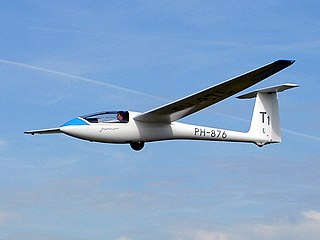
The ASW 24 is a modern single-seat high-performance composite Standard Class sailplane. It is manufactured in Germany by Alexander Schleicher GmbH & Co.

The Glaser-Dirks DG-400 is a single-seat self-launching motorglider that was produced by Glaser-Dirks between 1981 and 1992. It was the first self-launching motorglider with retractable engine and propeller to be produced in large numbers.

The PZL Bielsko SZD-50 Puchacz is a Polish two-place training and aerobatic sailplane.

The SZD-45 Ogar (Greyhound) is a T-tailed cantilever high-wing monoplane of wooden, aluminium and fibreglass construction designed and manufactured in Poland.

PZL.46 Sum (sheatfish) was a light bomber of the Polish Air Force before World War II, which, was directed to serial production in the spring of 1939. These planes were in production, but the Polish industry did not manage to produce them before the outbreak of the war.

PZL M-4 Tarpan was a Polish trainer and sports aircraft prototype of the 1960s, designed in WSK-Mielec.

The PZL P.6 was a Polish fighter, designed by the engineer Zygmunt Puławski, manufactured by PZL state-owned factory. It remained a prototype.

The PZL-105 Flaming (flamingo) is a Polish short-takeoff-and-landing (STOL) utility aircraft designed by PZL "Warszawa-Okęcie". It remained a prototype.

The PZL S-4 Kania 2 was a Polish trainer and glider towing aircraft of the 1950s, not built in series. The first prototype was designated S-3 Kania. There is also a helicopter named PZL Kania.

The PZL P.1 was a Polish fighter, designed by the engineer Zygmunt Puławski, manufactured by the PZL state-owned factory. It remained a prototype, but it was the first of the Polish PZL gull wing fighter series, leading to the PZL P.7, PZL P.11 and PZL P.24.
The ICA IS-32 is an open class high-performance metal two-seat sailplane produced in Romania in the 1970s. A refinement of the IS-28B, it shared most of that aircraft's fuselage, mated to new wings and empennage. This new wing had a span of 20 metres, featuring interconnected ailerons and flaps, Schempp-Hirth-type airbrakes. It had no provision for water ballast. The monowheel undercarriage differed from the IS-28 in being fully retractable.
The SZD-8 Jaskółka was a single-seat glider aircraft that was designed and built in Poland at Szybowcowy Zakład Doświadczalny in Bielsko-Biała from 1951.

The SZD-17X Jaskółka L was a single-seat high-performance competition glider designed and built in Poland at Szybowcowy Zakład Doświadczalny in Bielsko-Biała in 1955.

The SZD-18 Czajka was a single-seat glider designed and built in Poland in 1956.
The SZD-35 Bekas (Snipe) is a two-seater glider aircraft that was designed and built in Poland.

The SZD-48 Jantar Standard 2 is a Standard Class glider that was designed and produced in Poland starting in 1977.

The PZL Bielsko SZD-51 Junior is a Polish single-seat training and club sailplane.
The Akaflieg Darmstadt D-39 was a single-seat motor glider derived from the D-38 sailplane. Built in Germany in the late 1970s, it was not intended for production and only one was constructed.

The SZD-42 Jantar 2 is a single seat Open Class competition glider, designed and produced in Poland in the 1970s. It features a span of over 20 m (66 ft) and elastic, camber changing flaps. It was placed second, third and seventh at the 1976 World Gliding Championships. Over one hundred were built and more than ninety remain registered.
The Schleicher K 10 is a Standard class competition glider, designed by Rudolf Kaiser and built in Germany in 1963. Only a few were produced.















